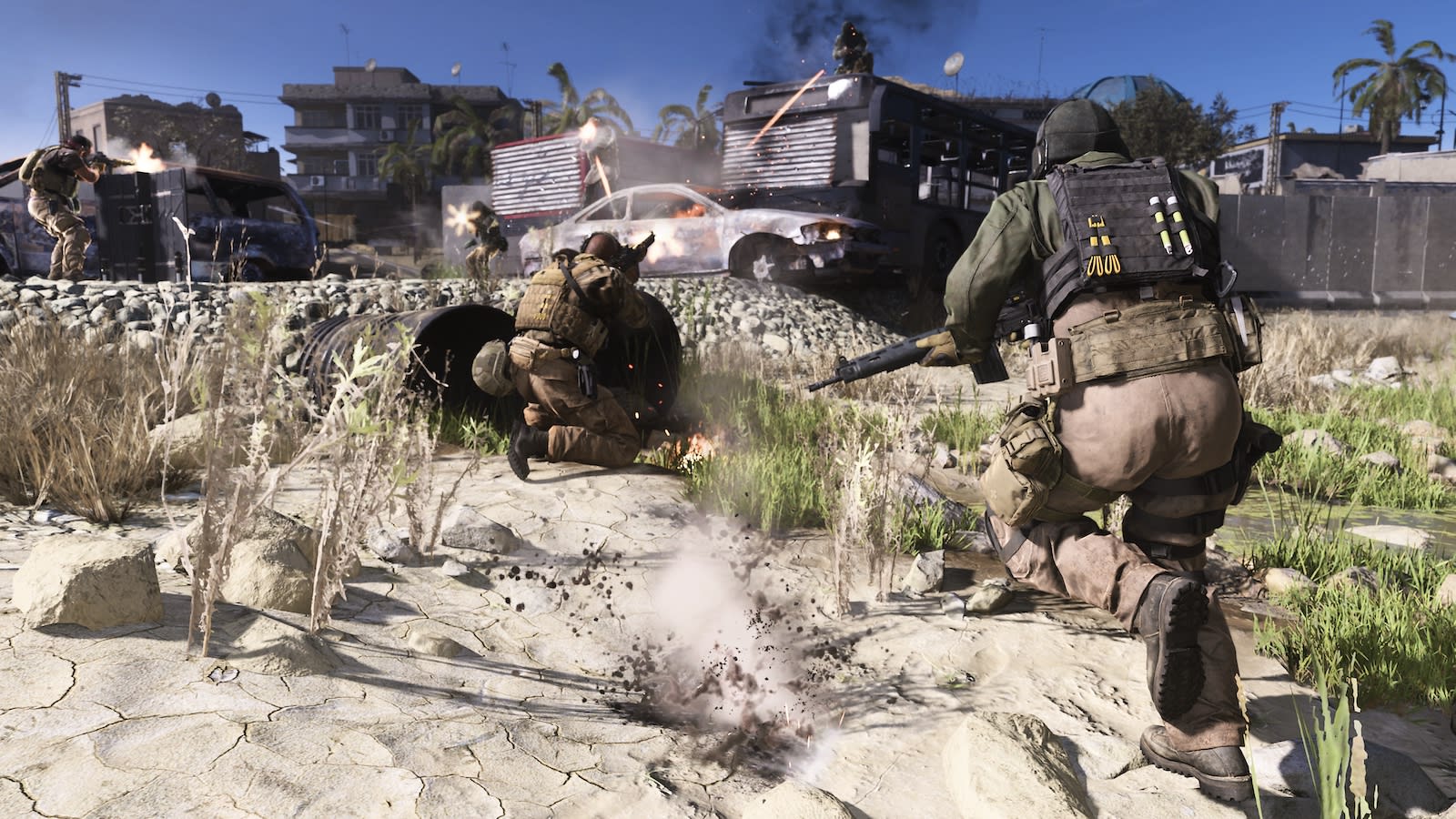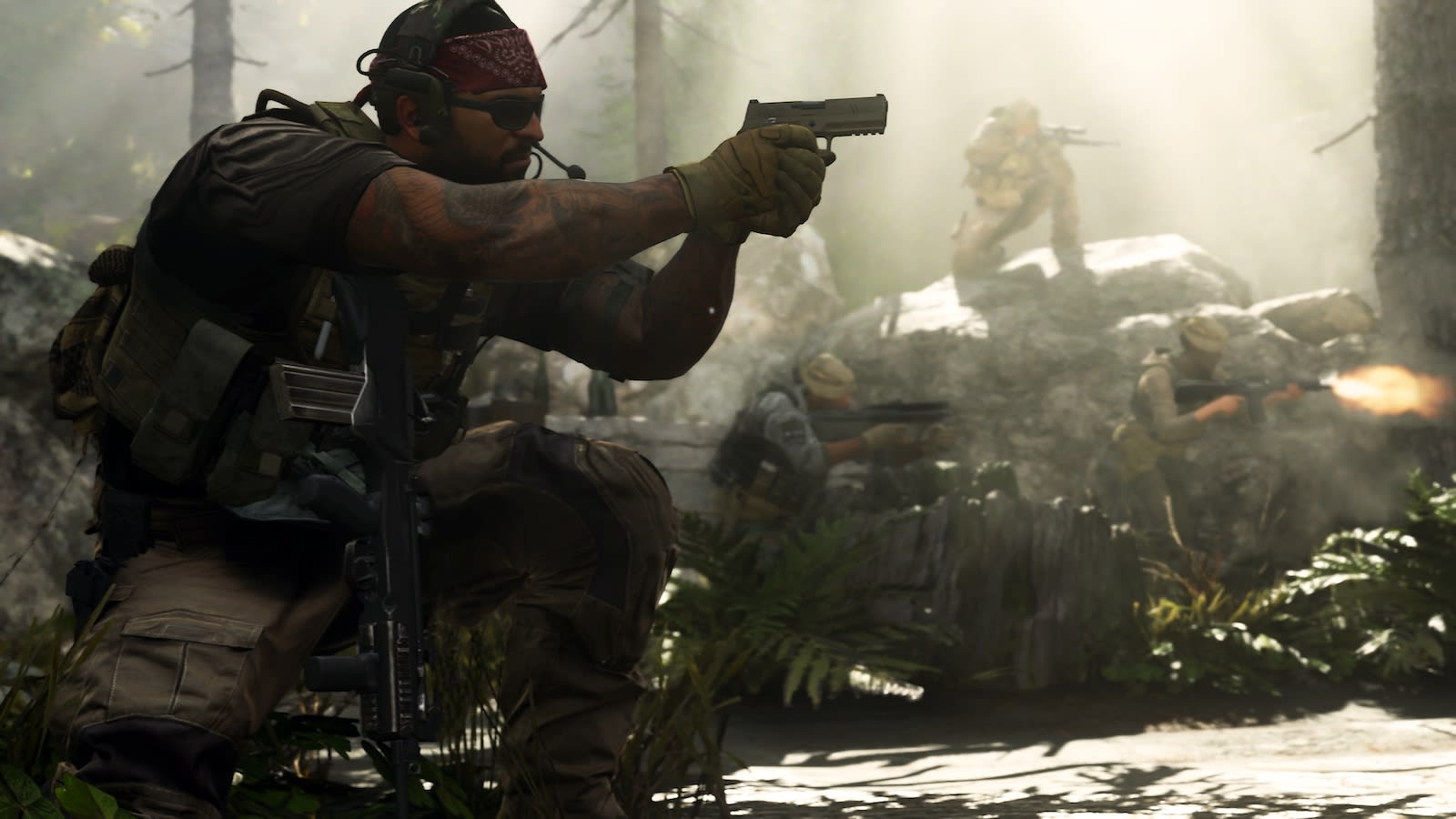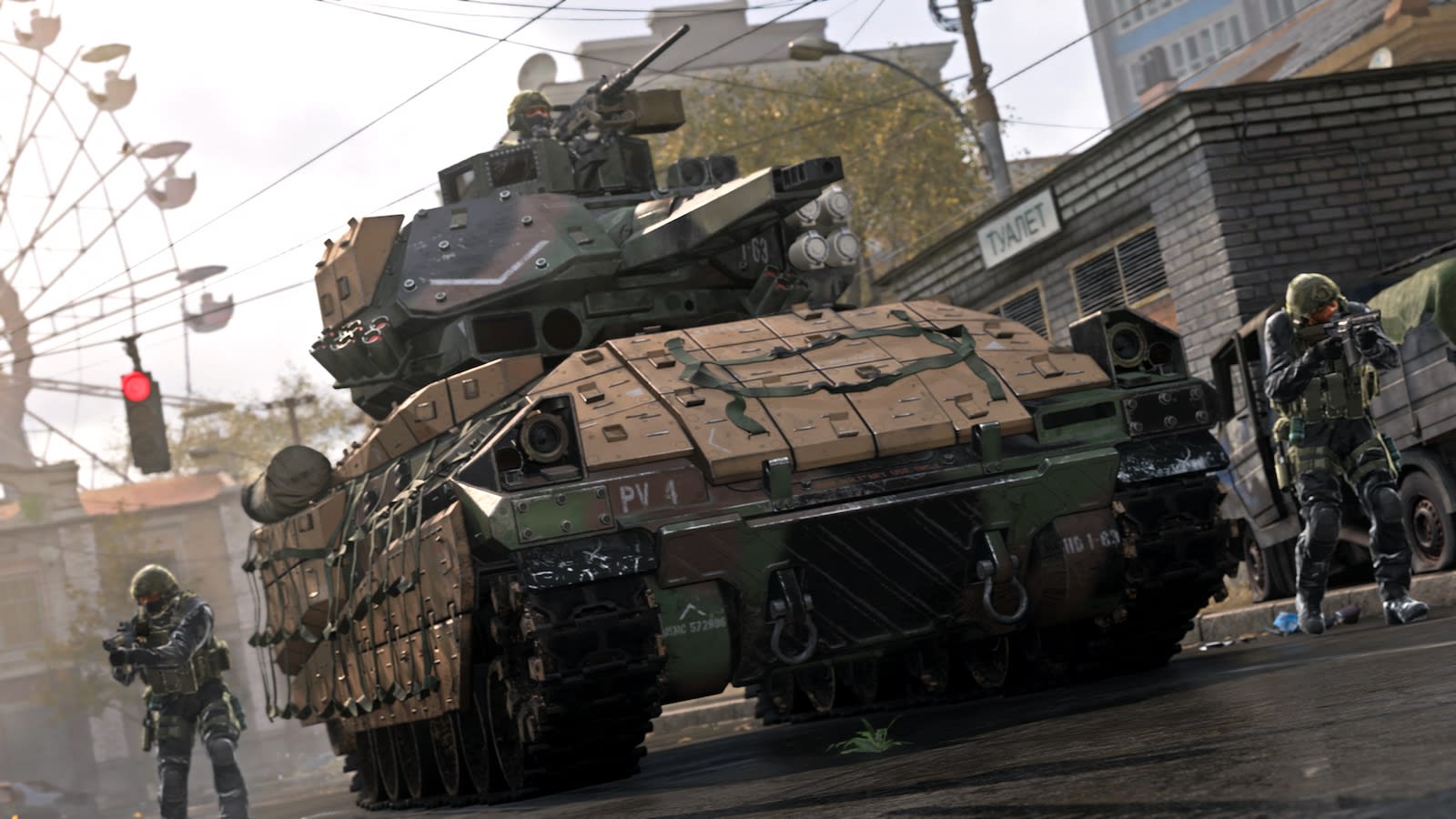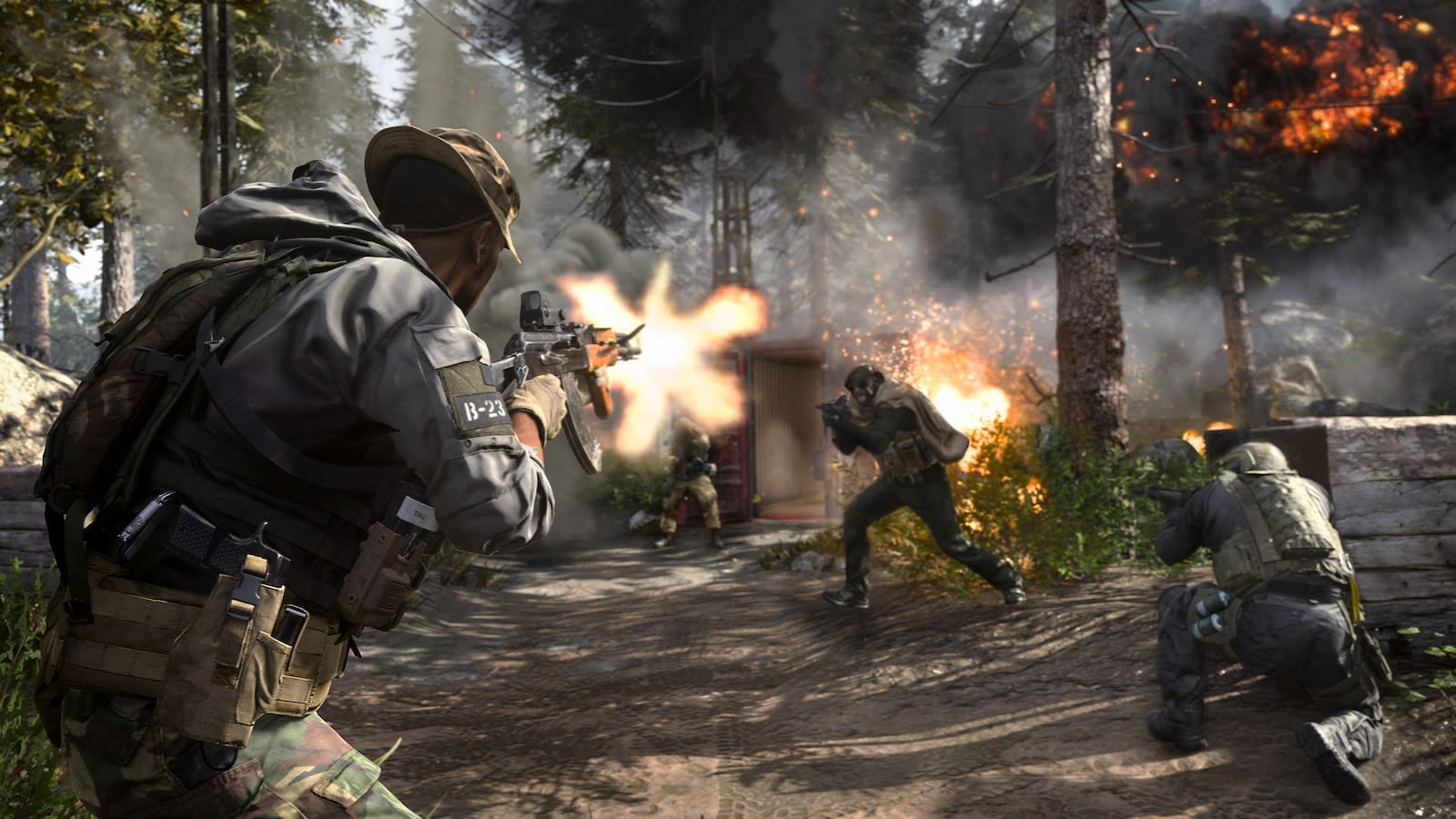
When Infinity Ward CEO Patrick Kelly introduced the single-player portion of Call of Duty: Modern Warfare to journalists in May, he sat at the front of a dim, intimate theater in the heart of his studio, and spoke as if he were divulging a delicious secret. This Call of Duty was going to be different than the 15 iterations that had come before, he said. It was going to be real. He showed off a preview of the solo campaign that began under a pile of rubble, right after a bombing in the fictional country of Ursekstan. The main character, a young girl named Farah, heaved at the debris and screamed as she found her mother crushed to death beside her. By the end of the demo, Farah had witnessed her father’s violent murder, stabbed and killed a cartoonishly homicidal Russian soldier, run through poison gas, hidden from mass execution squads, and fired her first gun.
“The vision for the game, the first thing we’re trying to do is, we’re trying to reflect the world we all live in,” he said at the beginning of the presentation. “We talk about like, you could see the story unfolding on CNN or a Frontline talking about it. Because we want this game to be as relevant as possible in the world that we live in, and a lot of the events, and a lot of the things that shaped the game, are based on the world that we live in.”
When Kelly introduced the multiplayer portion of Modern Warfare to the media, he stood in front of a packed audience at an off-site studio, where three hangars were drenched in Call of Duty swag and a food truck passed out free grub in the parking lot. Rows of PCs and PlayStation 4s running the game filled one warehouse, while another room held podiums with military-grade night-vision goggles begging to be tried on and Instagrammed. Kelly still spoke as if he were sharing a secret, but this time, he was standing on a stage.
“The first thing, and absolutely, arguably the most important thing, is gameplay is king,” he said to kick off the show. “Whatever we do, whether it be a narrative moment, whether it be an effect or whether it be anything, is it in the service of fun on the controller? Is it in service of gameplay?”
He ran down a few more bullet points, paired with slides and animations flashing on the huge screen behind him. Developers wanted Modern Warfare to be authentic and gritty, unified across all modes, technically state-of-the-art and —
“Badass fun,” Kelly said with a laugh. “We want you to be in the shit. We want the explosions, we want the effects, we want the gameplay, we want the feel of the guns down the barrel, everything you’re doing to be badass. But ultimately fun. We want you to have fun playing the product.”
Don’t get it wrong — Modern Warfare multiplayer is exceptionally fun. After playing three hours of Team Deathmatch, Gunfight and Cyber Attack, it’s clear that developers were focused on crafting strategically dense, realistic environments with plenty of new ways to hide, climb, stalk and camp. There are no three-lane maps in Modern Warfare, and the customization options are rich. It’s a thoughtful, fresh approach to Call of Duty multiplayer.
But there’s tension underlying the development of Modern Warfare. It’s a dissonance between the giddy excitement of shooting, dying and respawning that filled the multiplayer hangar, and the real-world story about child soldiers at the center of the single-player campaign I saw in May. It’s the difference between what Call of Duty is known for, and what Infinity Ward wants it to be.
“It’s definitely a conversation that happens very often,” game director Jack O’Hara said just after this week’s multiplayer presentation. “There’s always a tension behind it. And I don’t know that anybody knows the perfect answer for it or is gonna nail it. We, in multiplayer, we’re always aiming for this fun, visceral experience you’re playing with your friends, and we’re trying to wrap as much of the universe into that as possible. It’s a constant tension, I’d say. We talk about it pretty much every day.”
Authenticity is important to the Modern Warfare team, whether in weapon design, location scouting, audio output, animation or narrative. It’s the second point Kelly mentioned in his multiplayer presentation, and it’s what developers come back to when their creative decisions are questioned. Each bullet fired has layers of lifelike, location-specific audio cues; animations have been upgraded to include realistic gun blur, recoil and movement speeds; activating night-vision goggles reveals details accurate to real-world infrared visuals; the scenes were painstakingly stitched together with photogrammetry and microtiling.
Modern Warfare is stacked with soldiers from the US, UK, Russia and other actual nations, and the Russian characters even speak in Russian, with subtitles. Meanwhile, the Syria proxy where Farah lives, Ursekstan, is completely fictional, and the characters from there speak accented English.
Developers at both presentations happily talked about consulting with Marines, SEALs and combat veterans as part of the research process. No one mentioned speaking with civilian survivors of war or former child soldiers. Not even ones from Ursekstan.
Developers were upfront in the initial May presentation that they were still working on Modern Warfare, and they wanted feedback so they could make alterations if necessary. One thing they’ve since removed is a line delivered by a Russian soldier, who talks about giving a young girl he’s captured to a commanding officer who “likes the young ones.”
In an interview with Kotaku at E3, before the line was removed, single-player design director Jacob Minkoff defended the game’s provocative civilian sequences by repeating the importance of being true to even the ugliest real-world war scenarios. He said Infinity Ward had consultants on staff to help with sensitive sections, but when he was pressed about the team’s research into war-time pedophilia, in support of that line, the mantra of authenticity fell aside.
“This is a fictionalized world,” he told Kotaku. “This is not real life. This is not real politics. This is not even a real country in the world. So, no. These events are not specific to any real-world research. What this is, is an entertainment product with a fictional story.”
That line, and a scene it apparently alluded to later in the game, won’t be in the final version.
There’s a dominant perspective at the heart of Modern Warfare (well, after waltzing past the USA-good, Russia-bad, Western-first foundation supporting this game and the entire Call of Duty series). It’s the soldier’s perspective.
Not that this is a surprise — Call of Duty is the first-person shooter. It’s a series about soldiers in battle, and it’s done well for itself with this model, even while stomping through cultural, moral and political minefields. However, with a campaign steeped in “authentic and gritty” wartime scenes, told from the perspective of people whose lives are being torn apart in the most violent way, in reality, right now, Modern Warfare is attempting to do something new. And Infinity Ward wants players to know it.
“We’re trying to be provocative, we’re trying to be edgy, but we’re not trying to be tasteless or overly sensational or anything like that,” Kelly said in May.
About an hour before the Modern Warfare multiplayer presentation kicked off, I heard an interview on NPR with Waad al-Kateab, the Syrian filmmaker behind the coming Frontline documentary For Sama. For five years, she filmed daily life in her hometown of Aleppo as it was consumed by war, choosing to stay, get married and have a child with her husband, one of the few remaining doctors in the city. Al-Kateab documented bombings, close calls and deaths by the day. She saw homes and hospitals destroyed in an instant, and filmed mothers weeping by the bodies of their children.
Not once during the interview was she asked to defend the authenticity of her story, nor did she offer to. Aleppo is hers to tell.
“We don’t have any more emotional distance from this kind of stuff than the men and women who put their lives on the line and fight in these wars every day do,” Infinity Ward narrative director Taylor Kurosaki said in May. “That’s all. We’re not morbid. We’re not immune to things that feels shocking or are heavy, but if you’re going to be effective in the world of Modern Warfare, as an operator, as a fighter, as someone who has a chance of making a difference, you have to have a certain level of emotional detachment to be able to do your job. And so do we.”
Real-world war is not off-limits for video games. Some of the most powerful interactive experiences of the past decade have spawned from such trauma, such as 1979 Revolution: Black Friday and Bury Me, My Love. It’s notable that these games were built by or directly reference people who lived through the situations they cover.
As it stands, Modern Warfare is a first-person shooter built for esports and endlessly replayable multiplayer sessions, based on the idea of embodying a soldier in a contemporary battlefield. It also has a narrative campaign about the perceived reality of becoming a child soldier. These are fine goals individually, though they become uncomfortable when combined into a single billion-dollar product.
Quantifiably, the balance between single-player and multiplayer in Modern Warfare is off, and not only because multiplayer is Call of Duty’s bread-and-butter (the previous installment in the series didn’t even have a solo campaign). The solo portion of Modern Warfare considers the civilian’s perspective (a noble narrative goal) and the soldier’s perspective (a fun and necessary inclusion). Multiplayer, however, only considers the soldier. Fun naturally outweighs narrative. In a Call of Duty game, it has to. After all, “Gameplay is king.”
Author: Jessica Conditt
Source: Engadget
Tags: activision, av, call of duty, call of duty modern warfare, editorial, gaming, Infinity Ward, modern warfare, personal computing, personalcomputing, war







